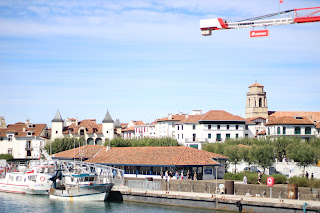On the morning of Thursday, September 8th, we had a walking tour of Bayonne. Our guide, a New Zealander named Andy Fisher, who has been living in Bayonne for 40 years, was one of the best local guides we've ever had. You wouldn't think that Bayonne would provide much in the way of interest, but he brought in the history and ethnography of the whole region--Eleanor of Aquitaine, Henry II, Basques, Gascons, English, French.
Next, we stopped at the big city market, to sample some cheese. The market has everything you could want to eat, including horsemeat.
After getting our own lunch (takeout sandwiches from Mokofin, which we ate in the Jardin Leon-Bonnat, we joined the tour of the Museum of Basque Culture.
Then we took the train to the beach resort of St.-Jean-de-Luz, near the Spanish border. It was very warm, in the 90s Fahrenheit. From the train station, we crossed the river into Ciboure, and easily found the house, designed by a Dutch architect, where the composer Maurice Ravel was born. During St.-Jean's one other brush with history, the wedding of Louis XIV and the Infanta Maria Theresa of Spain in 1660, the house hosted Cardinal Mazarin, the king's chief minister. Ravel only lived in the house for a few months, before his family moved to Paris, but he often returned to Ciboure (his mother was Basque), and wrote Bolero there.
The Church of St.-Jean-Baptiste was spiffed up in 1660 for the royal wedding. Like many Basque churches, it has interior balconies (for the men). Also, for some reason, it has a model of an early steamship hanging from the ceiling.
Next, we walked past, not to, the beach, on the way to Pointe Ste.-Barbe.
On the way back to the station, we rewarded our efforts with ice cream cones.
Back in Bayonne, we had a nice dinner out overlooking the Nive River, at Le Bayonnais.
























































